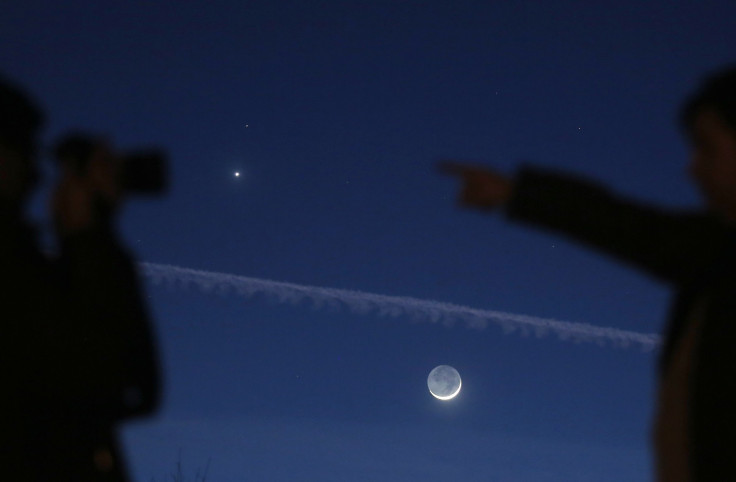Venus And Mars: Planets' Dance Visible Next To Crescent Moon In Friday, Saturday Night Sky [PHOTOS]

If you're brave enough to go outside and face the cold this weekend, look up -- you could see Venus and Mars in the night sky. The two planets are expected to do a so-called dance as they orbit the Sun, appearing closest on Saturday and Sunday. On Friday, they'll make a celestial triangle in the west-southwest sky with the young crescent moon.
"This is one of the more impressive things you'll be able to see with the naked eye. It should look pretty neat with binoculars, too," Arizona State University professor Patrick Young told The Republic.
Venus will look the brightest, and reddish Mars will be a short distance above it -- about the thickness of your thumb if held up at arms' length. The planets haven't appeared this close together in the sky since 2008, according to Planetsave.
Venus, about 134 million miles from Earth this weekend, and Mars, about 203 million miles away, are both passing on the far side of the sun. The Washington Post reported that viewers this month can also see Jupiter in the east at dusk and Saturn near the constellation Scorpius after 1 a.m.
Earlier this week, astronomers saw a similar convergence of events when there was a new moon, a Supermoon and Black Moon on the same night.
Young said these events aren't physically significant but make for good photos. Universe Today recommended using a smartphone's autofocus and autoexposure features to take several photos at a time. Leave your finger off the screen so the picture doesn't blur, and don't zoom in or your resolution will suffer.
Twitter users seemed to use these tricks Friday night as they posted dozens of pictures of the cosmic triangle. Here are a few of the best shots of the sky:
Beautiful. Via @ernad_selimagic: the moon, Venus and Mars above my uncle's house in Bosnia. pic.twitter.com/dehhWw6eRJ
— writing pis (@writingpis) February 21, 2015The #Moon, #Venus, and #Mars are interstellar dancing partners in the sky over CT @thedayct pic.twitter.com/FrWhefhWpH
— Tim Cook (@TimCook_photo) February 21, 2015#Moon, #Venus and #Mars conjunction over Grand Island, #NewYork. By Craig K. https://t.co/iIGRWeLB8v pic.twitter.com/xGmcqftsFL
— Epic Cosmos (@EpicCosmos) February 21, 2015DC, look up! Waxing crescent moon, Venus and Mars pic.twitter.com/GnyCfP8hsp (pic: @JimKnappPhotog)
— Erin Ruberry (@erinruberry) February 21, 2015The view of the crescent moon, bright Venus, and Mars from near Charlotte, NC. pic.twitter.com/xrEERe5naD
— Brad Timerson (@btimerson) February 20, 2015The #Moon, #Venus and #Mars appearing over the Pacific Ocean. Gabriel Brammer. https://t.co/S8s4YP3mMI pic.twitter.com/TNSDtcO78L
— Epic Cosmos (@EpicCosmos) February 21, 2015Something besides snow: Moon, Venus and Mars tonight (from Roslindale). @universalhub @ericfisher pic.twitter.com/I0C3o7Tken
— Ed Grzyb (@egrzyb) February 20, 2015Happy Lunar New Year everyone! Here's a shot of the New Moon this eve over #Birmingham Can you spot Venus and Mars? pic.twitter.com/hmoSAfdAyp
— Tim Cornbill (@timcornbill) February 20, 2015© Copyright IBTimes 2024. All rights reserved.






















